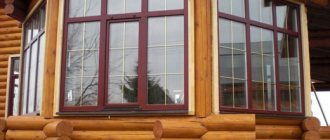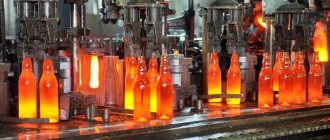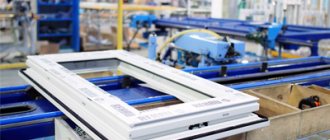Glass production dates back more than 5 thousand years. All this time, its manufacturing technologies have not stood still, constantly developing and becoming more and more efficient. Over the past fifty centuries, glass production has evolved from artisanal workshops with heavy manual labor to modern industrial complexes with a high degree of automation. Let's look at what glass manufacturing technologies are used today.
Currently in Russia there are 30 industrial enterprises specializing in glass production. Of these, 11 largest factories produce 90% of all domestic glass products. In addition, over fifty large enterprises are engaged in the recycling of already produced products - reinforcement, application of decorative coatings, hardening, etc. The share of the glass industry in the overall performance of the Russian industry is very significant.
Based on the results of 2022, the main consumers of glass industry products in Russia are:
- The construction industry uses 70% of all glass produced in the country.
- Transport engineering - 25%.
- Other industries and household needs - 5%.
Every year, since the beginning of the 2000s, the volume of consumption of glass products in the domestic market of the Russian Federation has been steadily increasing. Domestic production is also growing, which is especially stimulated by the country’s policy of complete import substitution in all areas of industry.
The following steps are followed in the glass production process:
- preparation of raw materials and formation of the charge;
- glass melting;
- cooling;
- product molding;
- annealing and processing.
Production raw materials
In glass production, the following chemicals can be used as the main material: oxides, fluorides or sulfides. The classical, most common technology involves the use of quartz sand as the main ingredient (up to 70% of the total mass), containing a large amount of silicon oxide SiO2. Dolomite and limestone, as well as sodium sulfate, are used as additional components.
Glass-forming oxides are added to the mixture as a catalyst and accelerator for the glass formation process. In addition, to give the glass produced certain required properties, additional components are introduced into its composition - tinting materials made on the basis of manganese, cobalt, chromium; clarifiers made from nitrate or arsenic oxide.
Depending on the main glass-forming raw materials and additional components, the following types of glass are available:
- Silicate. Their production is based on silicate oxide SiO2. The main variety used today everywhere in everyday life and in industry. These are window and car glass, mirrors, TV screens and computer monitors.
- Sodium-calcium. This type of glass is also called “soda” or “crown glass”, and is distinguished by its ease of melting and softness, which makes it easy to process. Often used for the manufacture of small parts of complex designs, or in decorative arts.
- Potassium-calcium, or potash. Characterized by refractoriness and hardness. The production of potash glass required a large amount of wood, the main raw material for potash. To get one kilogram of potash it was necessary to burn a ton of trees, so this type of glass was also called “forest glass.” Until the 18th century in Russia, potash glass was the main type produced by the domestic glass industry.
- Lead. In everyday life, this type of glass is better known as “crystal”. The production of crystal differs from traditional technology by introducing lead oxide into the composition as an additional component. The result is heavy glass products that have a bright shine and the ability to dispersion—the decomposition of a light beam into individual components. As a result, when passing through the crystal, the light begins to play with all the shades of the rainbow.
- Borosilicate. It is characterized by high mechanical resistance to various aggressive influences: refractoriness, immunity to acidic and alkaline environments, sudden changes in temperature. This is achieved by introducing boron oxide into the glass mass during the manufacturing process. The cost of borosilicate glass is higher than that of simple silicate glass, but its high mechanical properties more than compensate for this disadvantage. Used for the manufacture of medical and laboratory glassware.
Classification of glass products
Around a person there are a lot of objects made of glass or with its inclusions. They can be summarized by intended use.
Main groups of glass products:
Glass melting procedure
The production of glass mass is a complex process consisting of several stages. The first stage involves preparing the mixture with the addition of the necessary components in a given proportion. Next, the glass melting furnace is heated to a temperature of about 400 ºC. At this stage, the moisture contained in them evaporates from the ingredients, and thermal decomposition of various salts occurs. Then the temperature gradually increases to +800…900 ºC. At this stage, the process of chemical interaction between all initial components is completed.
The second stage of glass formation begins when the temperature of the melting furnace increases to 1100 ºC. All previously remaining unbound components are completely dissolved in the glass melt. The result is a transparent glass mass, but not a homogeneous substance in its composition. Also, its volume is saturated with a large number of gas bubbles. Next, the production process is reduced to further heating of the melt to t = 1500 ºC. At this temperature, gas bubbles rise to the surface of the melt and burst or dissolve in the liquid glass.
At this stage, the final clarification of the glass is carried out. The composition of the molten liquid becomes homogeneous due to intensive mixing by gas bubbles rising to the surface. This completes the production of the glass melt - the longest and most labor-intensive stage in the entire process.
Molding technology
The next step is to obtain a workpiece of a certain shape from the melt. Most often, this is sheet glass of a certain thickness and linear size. The modern glass industry has two technologies for producing sheet glass:
- Fourcauld method;
- Float method.
Fourcauld method
Fourcaud's technology received its name in honor of the French inventor who first introduced this method into production at the beginning of the twentieth century. This technology is based on the method of gradually drawing molten glass from a glass furnace through special rollers. As a result of continuous rolling of the glass mass, a long sheet was obtained. As it was drawn out, the melt entered a special chamber, where it was gradually cooled by blowing heated air.
Then the cooled glass tape is cut into sheets of the required size using special glass-cutting machines. The thickness of the glass sheet is adjusted by changing the speed of drawing the melt from the furnace. Due to the peculiarities of its manufacture, such glass was called “drawn”. Glass production using the Fourcaud method, despite its technological backwardness, is still used today. True, this technique is increasingly losing its position in the glass industry to another technology - the float method.
Float method
The production of sheet glass using the float method is a more modern method than the drawing technology. The name of this method comes from the English word “float”, which means “to float”. The inventor of this technique is considered to be the British glass industry, which was the first to develop and introduce into production this method of producing sheet glass. A little more than half a century has passed since the invention of the float method, but today it has become the main technology, replacing the Fourcaud pulling method everywhere.
A special feature of this method is the production of sheet glass by molding it on the surface of a metal melt. From the melting furnace, liquid glass is poured into a bath filled with molten tin. The glass melt, being lighter than tin, spreads over its surface, gradually solidifying. This is achieved by the fact that the melting point of tin is much lower than that of glass - a glass sheet is formed on the surface of liquid tin. Its thickness is determined by a certain volume of liquid glass poured into the bath, and the configuration of the sheet is determined by the shape of the bath itself. The production of sheet glass using the float method is today the main technology in the glass industry not only in Russia, but throughout the world.
Manufacturing of special types of glass products
Glass production is not limited to rectangular sheets. The modern glass industry supplies the market with a wide range of glass products used in a wide variety of sectors of the national economy and in everyday life.
- Automotive glass. The main requirement for external glazing of a car is the strength of the glass and the absence of the danger of flying fragments during an accident. Therefore, the production of auto glass is carried out in two stages: casting two identical glass blanks and gluing them together using a special film. The result is a multi-layer structure, held together with adhesive tape. In the event of an accident, fragments of broken car windows remain hanging on the inner film, and the risk of injury from broken glass is minimized.
- Glass container. The production of glass containers - cans, bottles and other containers - makes it possible to provide a number of industries with the necessary utensils, primarily the food and pharmaceutical industries. The manufacturing procedure is reduced to the following stages: obtaining a glass melt; casting containers of a certain shape and volume; hardening of the resulting products.
- Wired glass. The production of reinforced glass involves the simultaneous molding of a sheet with the introduction of a reinforcing metal or polymer mesh into it. This gives the sheet greater mechanical strength and resistance to impact loads, bending and fracture stresses.
- Glass optical fiber. Recently, the production of optical glass fiber has been gaining momentum. It is used in various fields of electrical engineering and fiber optics for transmitting video images. Optical fiber consists of a series of transparent glass strands formed into cable bundles. Welding of glass transmission threads is carried out using special equipment.
- Colored glass. The production of tinted glass has been known for hundreds of years. The required color is given to the glass melt using various additives. Most often they are manganese, cobalt and other metals that can react chemically with the main glass ingredients.
As you can see, the modern glass industry is a high-tech industry that produces dozens of varieties of products. Thanks to scientific and technological progress, the newest varieties and types of glass with improved physical and chemical characteristics and intended for use in a wide variety of industries regularly enter the world market.
Rate this article:
Rating: 0/5 — 0 votes
Useful and profitable business: production of glass bottles, jars and other containers from cullet
A business area such as glass recycling still remains underdeveloped .
And the point here is not at all a low return on costs, but rather a lack of understanding of the essence of the technology.
In addition, the country lacks an effective waste management system and modern management tools are not applied.
Let us note the advantages of producing glass containers from glass production waste:
- saving energy resources;
- waste-free production;
- reducing the burden on the environment;
- localization of solid waste landfills.
Technological aspects of glass processing
There are several technologies for recycling glass waste.
They have slight differences depending on the desired quality of the product and the planned costs of its production, but in general they consist of the same processes :
- Preparing raw materials for work - sorting, removing waste, washing, drying.
- Splitting up.
- Adding special fillers to glass chips that improve the quality of the finished product.
- Loading raw materials into molds.
- Feeding the filled forms into the glass melting furnace.
- Blowing new bottles and annealing them.
- Cooling of glass containers.
- Inspection of finished products and packaging.
To prepare glass for work, special separators equipped with magnetic elements, as well as devices that form a vacuum environment, are used.
Opening a business for the production of glass containers from recycled materials requires solving a number of priority tasks .
Let's look at them sequentially.
Room
To install a production line for the production of glass bottles and jars, you will need suitable premises .
The most suitable option is a building located away from a residential area that meets the following requirements :
- availability of sufficient energy capacity;
- connection to the water supply system;
- availability of good access road;
- an area that allows you to place the machine with all the necessary technological passages, as well as organize areas for receiving raw materials and storing the resulting products.
Equipment for the production of glass bottles, jars and other containers is quite expensive.
You can purchase the entire line by ordering it from the manufacturer according to the parameters you need, or you can buy each machine separately.
The production line must be equipped with the following types of equipment:
- glass supply line;
- raw material grinder;
- glass forming machine;
- glass melting furnace;
- cooler
It’s good if production processes are automated as much as possible - the work will have to be done with high-temperature material, and reducing the risk of injury in production will not only have a positive effect on the health of personnel operating the machinery, but will also result in income tax benefits.











